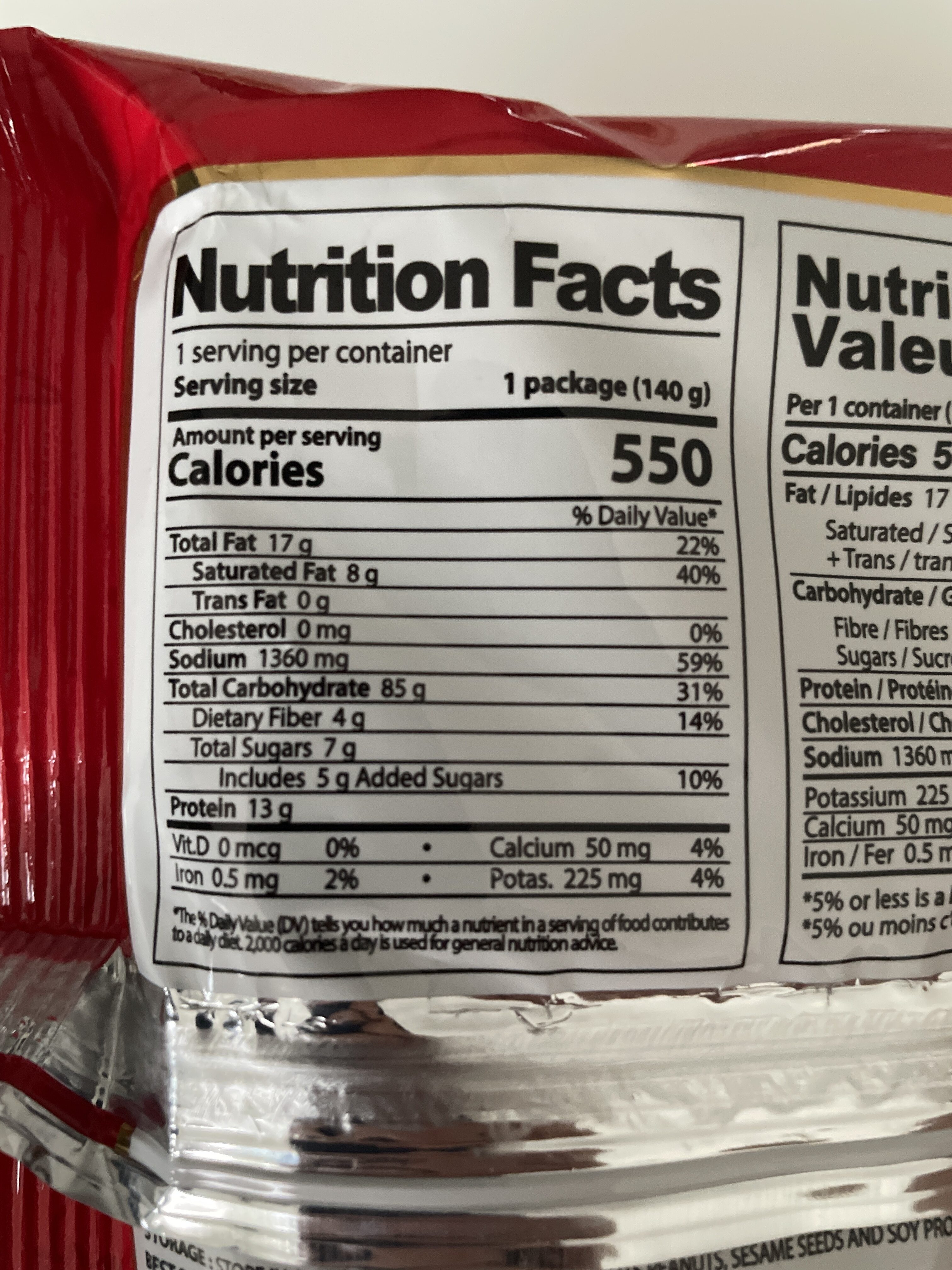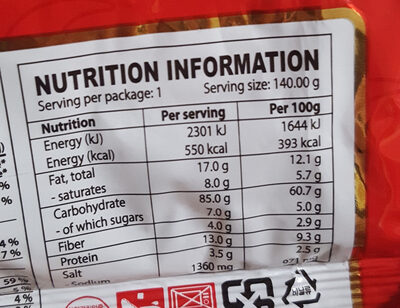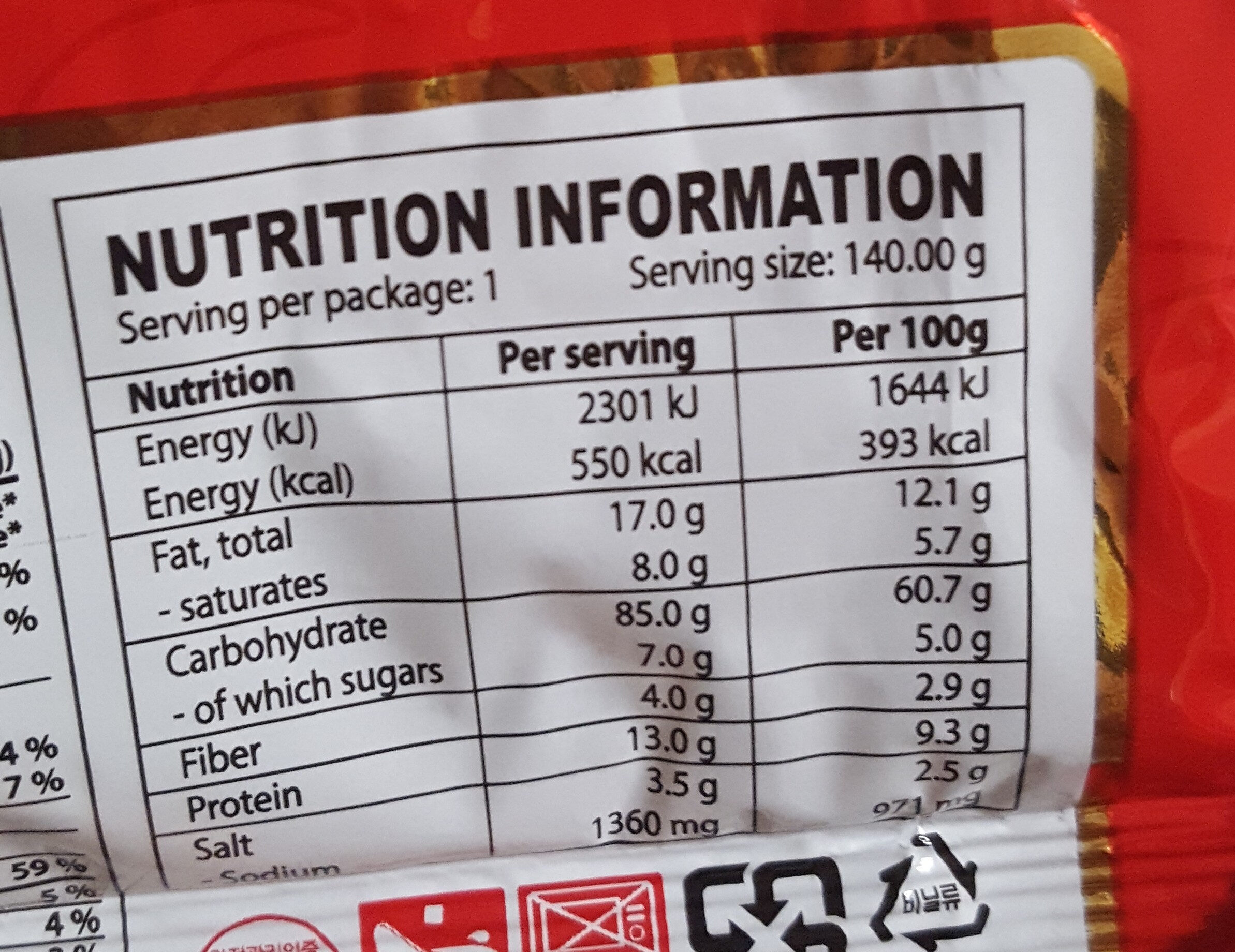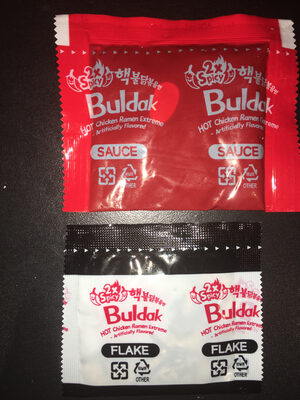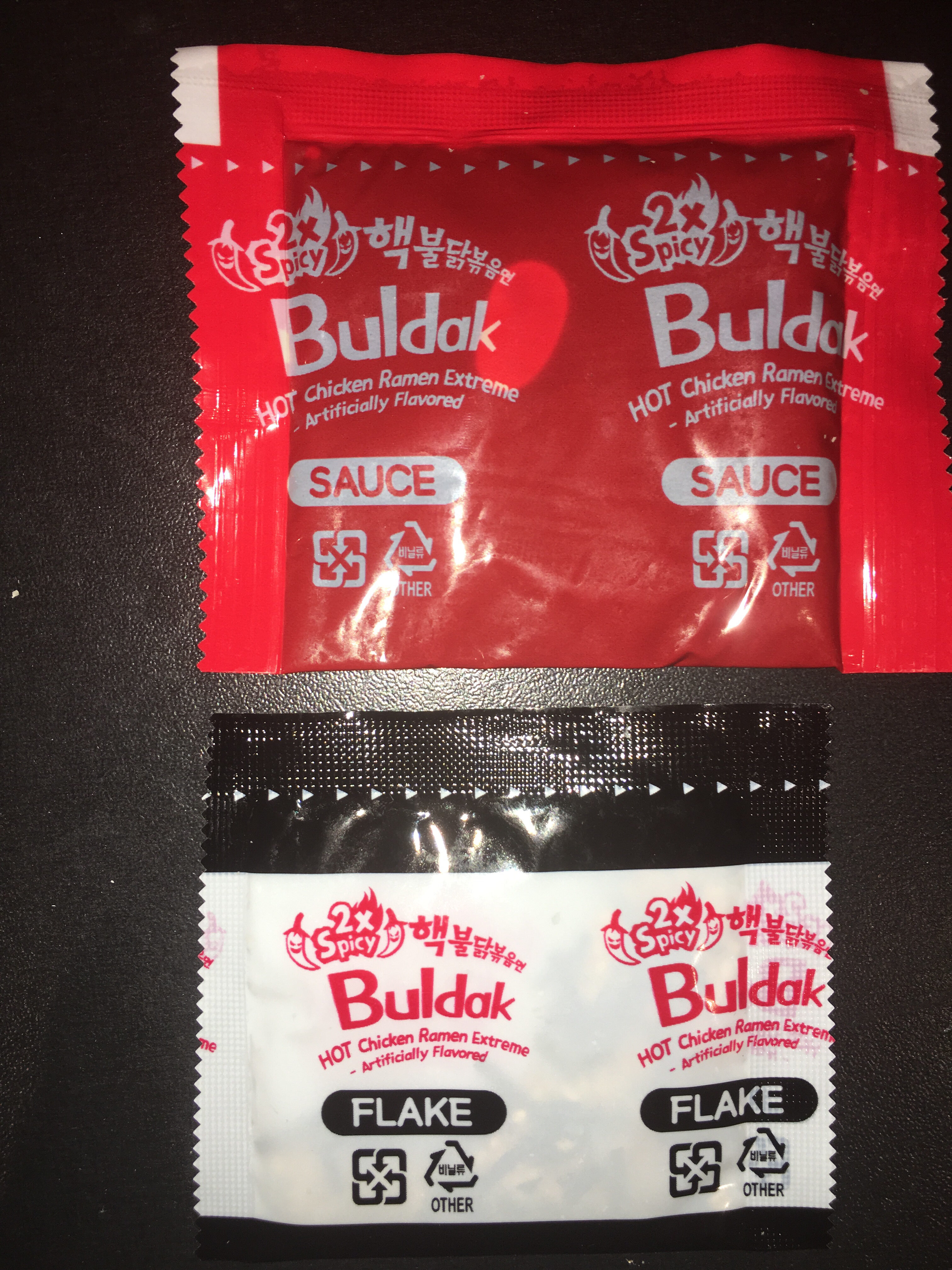Help us make food transparency the norm!
As a non-profit organization, we depend on your donations to continue informing consumers around the world about what they eat.
The food revolution starts with you!
Buldak Hot Chicken Flavour Ramen 2x spicy - Samyang - 140 g
Buldak Hot Chicken Flavour Ramen 2x spicy - Samyang - 140 g
Barcode: 8801073113428 (EAN / EAN-13)
Quantity: 140 g
Packaging: Plastic, O 7 - Other plastics, Bag, Individual bag
Brands: Samyang
Categories: Plant-based foods and beverages, Plant-based foods, Cereals and potatoes, Cereals and their products, Dried products, Pastas, Dried products to be rehydrated, Noodles, Instant noodles
Labels, certifications, awards:
Halal, de:Hergestellt in Südkorea
Origin of ingredients: South Korea
Manufacturing or processing places: Südkorea
Stores: Netto
Matching with your preferences
Health
Ingredients
-
43 ingredients
noodle (76,7%)(wheat flour, tapioca starch, palm oil, wheat gluten, salt, soybean oil, water, acidity regulator (potassium carbonate (e501), sodium carbonate (e500), sodium phosphate dibasic (e399), sodium polyphosphate (e452), citric acid (e330)), thickener ((guar gum (e412)) emulsifier (soy lecithin(e332)))), soup(22,7%)( water, artificial chicken flavor powder, white sugar, soy sauce, red pepper powder, soybean oil, onion powder, chilli extract, salt, garlic powder, tapioca starch, yeast extract powder, black pepper powder, curry powder), flakes(0,6%)(roasted sesame, roasted laver)Allergens: Celery, Gluten, SoybeansTraces: Crustaceans, Eggs, Fish, Milk, Molluscs, Mustard, Nuts, Peanuts, Sesame seeds
Food processing
-
Ultra processed foods
Elements that indicate the product is in the 4 - Ultra processed food and drink products group:
- Additive: E322 - Lecithins
- Additive: E412 - Guar gum
- Additive: E452 - Polyphosphates
- Ingredient: Emulsifier
- Ingredient: Gluten
- Ingredient: Thickener
Food products are classified into 4 groups according to their degree of processing:
- Unprocessed or minimally processed foods
- Processed culinary ingredients
- Processed foods
- Ultra processed foods
The determination of the group is based on the category of the product and on the ingredients it contains.
Additives
-
E322 - Lecithins
Lecithins are natural compounds commonly used in the food industry as emulsifiers and stabilizers.
Extracted from sources like soybeans and eggs, lecithins consist of phospholipids that enhance the mixing of oil and water, ensuring smooth textures in various products like chocolates, dressings, and baked goods.
They do not present any known health risks.
-
E322i - Lecithin
Lecithins are natural compounds commonly used in the food industry as emulsifiers and stabilizers.
Extracted from sources like soybeans and eggs, lecithins consist of phospholipids that enhance the mixing of oil and water, ensuring smooth textures in various products like chocolates, dressings, and baked goods.
They do not present any known health risks.
-
E330 - Citric acid
Citric acid is a natural organic acid found in citrus fruits such as lemons, oranges, and limes.
It is widely used in the food industry as a flavor enhancer, acidulant, and preservative due to its tart and refreshing taste.
Citric acid is safe for consumption when used in moderation and is considered a generally recognized as safe (GRAS) food additive by regulatory agencies worldwide.
-
E332 - Potassium citrates
Potassium citrate: Potassium citrate -also known as tripotassium citrate- is a potassium salt of citric acid with the molecular formula K3C6H5O7. It is a white, hygroscopic crystalline powder. It is odorless with a saline taste. It contains 38.28% potassium by mass. In the monohydrate form it is highly hygroscopic and deliquescent. As a food additive, potassium citrate is used to regulate acidity and is known as E number E332. Medicinally, it may be used to control kidney stones derived from either uric acid or cystine.Source: Wikipedia
-
E399 - Calcium lactobionate
Lactobionic acid: Lactobionic acid -4-O-β-galactopyranosyl-D-gluconic acid- is a sugar acid. It is a disaccharide formed from gluconic acid and galactose. It can be formed by oxidation of lactose. The carboxylate anion of lactobionic acid is known as lactobionate. As an acid, lactobionic acid can form salts with mineral cations such as calcium, potassium, sodium and zinc. Calcium lactobionate is a food additive used as a stabilizer. Potassium lactobionate is added to organ preservation solutions such as Viaspan or CoStorSol to provide osmotic support and prevent cell swelling. Mineral salts of lactobionic acid are also used for mineral supplementation. Lactobionic acid is also used in the cosmetics industry as an antioxidant and in the pharmaceutical industry as an excipient for formulation. For example, the antibiotic erythromycin is used as the salt erythromycin lactobionate when intravenously delivered.Source: Wikipedia
-
E412 - Guar gum
Guar gum (E412) is a natural food additive derived from guar beans.
This white, odorless powder is valued for its remarkable thickening and stabilizing properties, making it a common ingredient in various food products, including sauces, dressings, and ice creams.
When used in moderation, guar gum is considered safe for consumption, with no known adverse health effects.
-
E500 - Sodium carbonates
Sodium carbonates (E500) are compounds commonly used in food preparation as leavening agents, helping baked goods rise by releasing carbon dioxide when they interact with acids.
Often found in baking soda, they regulate the pH of food, preventing it from becoming too acidic or too alkaline. In the culinary world, sodium carbonates can also enhance the texture and structure of foods, such as noodles, by modifying the gluten network.
Generally recognized as safe, sodium carbonates are non-toxic when consumed in typical amounts found in food.
-
E500i - Sodium carbonate
Sodium carbonate: Sodium carbonate, Na2CO3, -also known as washing soda, soda ash and soda crystals, and in the monohydrate form as crystal carbonate- is the water-soluble sodium salt of carbonic acid. It most commonly occurs as a crystalline decahydrate, which readily effloresces to form a white powder, the monohydrate. Pure sodium carbonate is a white, odorless powder that is hygroscopic -absorbs moisture from the air-. It has a strongly alkaline taste, and forms a moderately basic solution in water. Sodium carbonate is well known domestically for its everyday use as a water softener. Historically it was extracted from the ashes of plants growing in sodium-rich soils, such as vegetation from the Middle East, kelp from Scotland and seaweed from Spain. Because the ashes of these sodium-rich plants were noticeably different from ashes of timber -used to create potash-, they became known as "soda ash". It is synthetically produced in large quantities from salt -sodium chloride- and limestone by a method known as the Solvay process. The manufacture of glass is one of the most important uses of sodium carbonate. Sodium carbonate acts as a flux for silica, lowering the melting point of the mixture to something achievable without special materials. This "soda glass" is mildly water-soluble, so some calcium carbonate is added to the melt mixture to make the glass produced insoluble. This type of glass is known as soda lime glass: "soda" for the sodium carbonate and "lime" for the calcium carbonate. Soda lime glass has been the most common form of glass for centuries. Sodium carbonate is also used as a relatively strong base in various settings. For example, it is used as a pH regulator to maintain stable alkaline conditions necessary for the action of the majority of photographic film developing agents. It acts as an alkali because when dissolved in water, it dissociates into the weak acid: carbonic acid and the strong alkali: sodium hydroxide. This gives sodium carbonate in solution the ability to attack metals such as aluminium with the release of hydrogen gas.It is a common additive in swimming pools used to raise the pH which can be lowered by chlorine tablets and other additives which contain acids. In cooking, it is sometimes used in place of sodium hydroxide for lyeing, especially with German pretzels and lye rolls. These dishes are treated with a solution of an alkaline substance to change the pH of the surface of the food and improve browning. In taxidermy, sodium carbonate added to boiling water will remove flesh from the bones of animal carcasses for trophy mounting or educational display. In chemistry, it is often used as an electrolyte. Electrolytes are usually salt-based, and sodium carbonate acts as a very good conductor in the process of electrolysis. In addition, unlike chloride ions, which form chlorine gas, carbonate ions are not corrosive to the anodes. It is also used as a primary standard for acid-base titrations because it is solid and air-stable, making it easy to weigh accurately.Source: Wikipedia
-
E501 - Potassium carbonates
Potassium carbonate: Potassium carbonate -K2CO3- is a white salt, which is soluble in water -insoluble in ethanol- and forms a strongly alkaline solution. It can be made as the product of potassium hydroxide's absorbent reaction with carbon dioxide. It is deliquescent, often appearing a damp or wet solid. Potassium carbonate is used in the production of soap and glass.Source: Wikipedia
-
E501i - Potassium carbonate
Potassium carbonate: Potassium carbonate -K2CO3- is a white salt, which is soluble in water -insoluble in ethanol- and forms a strongly alkaline solution. It can be made as the product of potassium hydroxide's absorbent reaction with carbon dioxide. It is deliquescent, often appearing a damp or wet solid. Potassium carbonate is used in the production of soap and glass.Source: Wikipedia
Ingredients analysis
-
Palm oil
Ingredients that contain palm oil: Palm oil
-
Vegan status unknown
Unrecognized ingredients: Sodium-phosphate-dibasic, Soup, Artificial-chicken-flavor-powder, FlakesSome ingredients could not be recognized.
We need your help!
You can help us recognize more ingredients and better analyze the list of ingredients for this product and others:
- Edit this product page to correct spelling mistakes in the ingredients list, and/or to remove ingredients in other languages and sentences that are not related to the ingredients.
- Add new entries, synonyms or translations to our multilingual lists of ingredients, ingredient processing methods, and labels.
If you would like to help, join the #ingredients channel on our Slack discussion space and/or learn about ingredients analysis on our wiki. Thank you!
-
Vegetarian status unknown
Unrecognized ingredients: Sodium-phosphate-dibasic, Soup, Artificial-chicken-flavor-powder, FlakesSome ingredients could not be recognized.
We need your help!
You can help us recognize more ingredients and better analyze the list of ingredients for this product and others:
- Edit this product page to correct spelling mistakes in the ingredients list, and/or to remove ingredients in other languages and sentences that are not related to the ingredients.
- Add new entries, synonyms or translations to our multilingual lists of ingredients, ingredient processing methods, and labels.
If you would like to help, join the #ingredients channel on our Slack discussion space and/or learn about ingredients analysis on our wiki. Thank you!
-
Details of the analysis of the ingredients
We need your help!
Some ingredients could not be recognized.
We need your help!
You can help us recognize more ingredients and better analyze the list of ingredients for this product and others:
- Edit this product page to correct spelling mistakes in the ingredients list, and/or to remove ingredients in other languages and sentences that are not related to the ingredients.
- Add new entries, synonyms or translations to our multilingual lists of ingredients, ingredient processing methods, and labels.
If you would like to help, join the #ingredients channel on our Slack discussion space and/or learn about ingredients analysis on our wiki. Thank you!
en: noodle 76.7%, wheat flour, tapioca starch, palm oil, wheat gluten, salt, soybean oil, water, acidity regulator (potassium carbonate (e501), sodium carbonate (e500), sodium phosphate dibasic (e399), sodium polyphosphate (e452), citric acid (e330)), thickener (guar gum (e412)), emulsifier (soy lecithin (e332)), soup 22.7% (water, artificial chicken flavor powder, white sugar, soy sauce, red pepper, soybean oil, onion, chilli, salt, garlic, tapioca starch, yeast extract powder, black pepper, curry), flakes 0.6% (sesame, laver)- noodle -> en:noodle - vegan: maybe - vegetarian: maybe - percent: 76.7
- wheat flour -> en:wheat-flour - vegan: yes - vegetarian: yes - ciqual_proxy_food_code: 9410
- tapioca starch -> en:tapioca - vegan: yes - vegetarian: yes - ciqual_proxy_food_code: 9510
- palm oil -> en:palm-oil - vegan: yes - vegetarian: yes - from_palm_oil: yes - ciqual_food_code: 16129
- wheat gluten -> en:wheat-gluten - vegan: yes - vegetarian: yes
- salt -> en:salt - vegan: yes - vegetarian: yes - ciqual_food_code: 11058
- soybean oil -> en:soya-oil - vegan: yes - vegetarian: yes - from_palm_oil: no - ciqual_food_code: 17420
- water -> en:water - vegan: yes - vegetarian: yes - ciqual_food_code: 18066
- acidity regulator -> en:acidity-regulator
- potassium carbonate -> en:e501i - vegan: yes - vegetarian: yes
- e501 -> en:e501 - vegan: yes - vegetarian: yes
- sodium carbonate -> en:e500i - vegan: yes - vegetarian: yes
- e500 -> en:e500 - vegan: yes - vegetarian: yes
- sodium phosphate dibasic -> en:sodium-phosphate-dibasic
- e399 -> en:e399 - vegan: yes - vegetarian: yes
- sodium polyphosphate -> en:e452i - vegan: yes - vegetarian: yes
- e452 -> en:e452 - vegan: yes - vegetarian: yes
- citric acid -> en:e330 - vegan: yes - vegetarian: yes
- e330 -> en:e330 - vegan: yes - vegetarian: yes
- potassium carbonate -> en:e501i - vegan: yes - vegetarian: yes
- thickener -> en:thickener
- guar gum -> en:e412 - vegan: yes - vegetarian: yes
- e412 -> en:e412 - vegan: yes - vegetarian: yes
- guar gum -> en:e412 - vegan: yes - vegetarian: yes
- emulsifier -> en:emulsifier
- soy lecithin -> en:soya-lecithin - vegan: yes - vegetarian: yes - ciqual_food_code: 42200
- e332 -> en:e332 - vegan: yes - vegetarian: yes
- soy lecithin -> en:soya-lecithin - vegan: yes - vegetarian: yes - ciqual_food_code: 42200
- soup -> en:soup - percent: 22.7
- water -> en:water - vegan: yes - vegetarian: yes - ciqual_food_code: 18066
- artificial chicken flavor powder -> en:artificial-chicken-flavor-powder
- white sugar -> en:white-sugar - vegan: yes - vegetarian: yes - ciqual_food_code: 31016
- soy sauce -> en:soy-sauce - vegan: maybe - vegetarian: maybe - ciqual_food_code: 11104
- red pepper -> en:red-bell-pepper - vegan: yes - vegetarian: yes - ciqual_food_code: 20087
- soybean oil -> en:soya-oil - vegan: yes - vegetarian: yes - from_palm_oil: no - ciqual_food_code: 17420
- onion -> en:onion - vegan: yes - vegetarian: yes - ciqual_food_code: 20034
- chilli -> en:chili-pepper - vegan: yes - vegetarian: yes - ciqual_food_code: 20151
- salt -> en:salt - vegan: yes - vegetarian: yes - ciqual_food_code: 11058
- garlic -> en:garlic - vegan: yes - vegetarian: yes - ciqual_food_code: 11000
- tapioca starch -> en:tapioca - vegan: yes - vegetarian: yes - ciqual_proxy_food_code: 9510
- yeast extract powder -> en:yeast-extract-powder - vegan: yes - vegetarian: yes - ciqual_proxy_food_code: 11009
- black pepper -> en:black-pepper - vegan: yes - vegetarian: yes - ciqual_food_code: 11015
- curry -> en:curry - vegan: yes - vegetarian: yes - ciqual_food_code: 11005
- flakes -> en:flakes - percent: 0.6
- sesame -> en:sesame - vegan: yes - vegetarian: yes - ciqual_food_code: 15010
- laver -> en:laver - vegan: yes - vegetarian: yes - ciqual_proxy_food_code: 20984
-
Nutrition facts
Nutrition facts As sold
for 100 g / 100 mlAs sold
per serving (140 g)Compared to: Instant noodles Energy 1,644 kj
(393 kcal)2,300 kj
(550 kcal)+30% Fat 12.1 g 16.9 g +8% Saturated fat 5.7 g 7.98 g +15% Carbohydrates 60.7 g 85 g +45% Sugars 5 g 7 g +96% Fiber 2.9 g 4.06 g +42% Proteins 9.3 g 13 g +43% Salt 2.5 g 3.5 g -5% Fruits‚ vegetables‚ nuts and rapeseed‚ walnut and olive oils (estimate from ingredients list analysis) 0 % 0 %
Environment
-
Eco-Score C - Moderate environmental impact
⚠ ️Select a country in order to include the full impact of transportation.The Eco-Score is an experimental score that summarizes the environmental impacts of food products.→ The Eco-Score was initially developped for France and it is being extended to other European countries. The Eco-Score formula is subject to change as it is regularly improved to make it more precise and better suited to each country.Life cycle analysis
-
Average impact of products of the same category: A (Score: 82/100)
Category: Asian noodles, flavoured, dehydrated
Category: Asian noodles, flavoured, dehydrated
- PEF environmental score: 0.26 (the lower the score, the lower the impact)
- including impact on climate change: 1.66 kg CO2 eq/kg of product
Stage Impact Agriculture
65.2 %Processing
20.8 %Packaging
8.7 %Transportation
3.5 %Distribution
1.8 %Consumption
0.0 %
Bonuses and maluses
-
Origins of ingredients with a medium impact
Bonus: +1
Environmental policy: +1
Transportation: 0
Origin of the product and/or its ingredients % of ingredients Impact South Korea 100 %Medium
-
Ingredients that threatens species
Malus: -10
Contains palm oil
Tropical forests in Asia, Africa and Latin America are destroyed to create and expand oil palm tree plantations. The deforestation contributes to climate change, and it endangers species such as the orangutan, the pigmy elephant and the Sumatran rhino.
-
Packaging with a high impact
Malus: -15
Shape Material Recycling Impact 1 Bag O 7 - Other plastics High 1 Individual bag O 7 - Other plastics High 1 Individual bag O 7 - Other plastics High
Eco-Score for this product
-
Impact for this product: C (Score: 58/100)
Product: Buldak Hot Chicken Flavour Ramen 2x spicy - Samyang - 140 g
Life cycle analysis score: 82
Sum of bonuses and maluses: -24
Final score: 58/100
-
Carbon footprint
-
Equal to driving 0.9 km in a petrol car
166 g CO² per 100g of product
The carbon emission figure comes from ADEME's Agribalyse database, for the category: Asian noodles, flavoured, dehydrated (Source: ADEME Agribalyse Database)
Stage Impact Agriculture
60.9 %Processing
14.9 %Packaging
16.3 %Transportation
6.9 %Distribution
1.0 %Consumption
0.0 %
Packaging
-
Packaging with a high impact
-
Packaging parts
1 x Bag 140 g (O 7 - Other plastics)
1 x Individual bag 32 g (O 7 - Other plastics)
1 x Individual bag 1 g (O 7 - Other plastics)
-
Packaging materials
Material % Packaging weight Packaging weight per 100 g of product Plastic
-
Transportation
-
Origins of ingredients
Origins of ingredients with a medium impact
Origin of the product and/or its ingredients % of ingredients Impact South Korea 100 %Medium
Threatened species
-
Contains palm oil
Drives deforestation and threatens species such as the orangutan
Tropical forests in Asia, Africa and Latin America are destroyed to create and expand oil palm tree plantations. The deforestation contributes to climate change, and it endangers species such as the orangutan, the pigmy elephant and the Sumatran rhino.
Report a problem
-
Incomplete or incorrect information?
Category, labels, ingredients, allergens, nutritional information, photos etc.
If the information does not match the information on the packaging, please complete or correct it. Open Food Facts is a collaborative database, and every contribution is useful for all.
Data sources
Product added on by kiliweb
Last edit of product page on by benbenben.
Product page also edited by date-limite-app, ecoscore-impact-estimator, foodless, inf, kaitocross, mvainola, odinh, openfoodfacts-contributors, poiar, quechoisir, tabyo, vaporous, vegan-app-chakib, worldtest, yuka.MJcYPPK7BpEqOMjojt9l8wC2KbfQPNMAQUItow, yuka.V2FJYUhhY0xyZk1FaHNNRzNRUGZwL3NxNDVLNFdGaTBEOEFVSVE9PQ, yuka.sY2b0xO6T85zoF3NwEKvlhNOdIDeszHqPizhoRWK9v7TAaK1WslUxNjLaKs.



